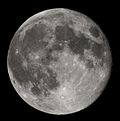- Magnetic field of the Moon
-
The external magnetic field of the Moon is very weak in comparison to that of the Earth. Other major differences are that the Moon does not currently have a dipolar magnetic field (as would be generated by a geodynamo in its core) and the varying magnetization that is present is almost entirely crustal in origin. One hypothesis holds that the crustal magnetizations were acquired early in lunar history when a geodynamo was still operating. The small size of the lunar core, however, is a potential obstacle to this theory. Alternatively, it is possible that on an airless body such as the Moon, transient magnetic fields could be generated during large impact events. In support of this, it has been noted that the largest crustal magnetizations appear to be located near the antipodes of the giant impact basins. It has been proposed that such a phenomenon could result from the free expansion of an impact-generated plasma cloud around the Moon in the presence of an ambient magnetic field.[1]
Roughly once every moon orbit, the Moon passes through Earth's magnetotail for approximately 6 days. Interaction with the plasma sheet causes the Moon's surface to become negatively charged. On the Moon's dayside this effect is counteracted to a degree by sunlight: ultraviolet photons knock electrons back off the surface, keeping the build-up of charge at relatively low levels. But on the nightside electrons accumulate and surface voltages can climb to hundreds or thousands of volts.
There's growing evidence that fine particles of moondust might actually float, ejected from the lunar surface by electrostatic repulsion. This could create a temporary nighttime "atmosphere" of dust. The moondust atmosphere might also gather itself into a sort of diaphanous wind. Drawn by differences in global charge accumulation, floating dust would naturally fly from the strongly negative nightside to the weakly negative dayside. This "dust storm" effect would be strongest at the Moon's terminator. Much of these details are still speculative, but the Lunar Prospector spacecraft detected changes in the lunar nightside voltage during magnetotail crossings, jumping from -200 V to -1000 V. The plasma sheet is a very dynamic structure, in a constant state of motion, so as the Moon orbits through the magnetotail the plasma sheet can sweep across it many times with encounters lasting anywhere from minutes to hours or even days.[2]
The Chandrayaan-1 spacecraft mapped a "mini-magnetosphere" at the Crisium antipode on the moon's far side, using its Sub-keV Atom Reflecting Analyzer (SARA) instrument. The mini-magnetosphere is 360 km across at the surface and is surrounded by a 300-km-thick region of enhanced plasma flux that results from the solar wind flowing around the mini-magnetosphere.[3]
See also
- Gravity field of the Moon
- Topography of the Moon
References
- ^ Hood, L. L., and Z. Huang, L. L.; Huang, Z. (1991). "Formation of magnetic anomalies antipodal to lunar impact basins: Two-dimensional model calculations". J. Geophys. Res. 96: 9837–9846. Bibcode 1991JGR....96.9837H. doi:10.1029/91JB00308.
- ^ NASA - The Moon and the Magnetotail
- ^ M. Wieser, et al. (2010), First observation of a mini‐magnetosphere above a lunar magnetic anomaly using energetic neutral atoms, Geophys. Res. Lett., 37, L05103, doi:10.1029/2009GL041721.
The Moon Physical features - Internal structure
- Gravity field
- Topography
- Magnetic field
- Atmosphere
- Ion tail
- Moonlight

Orbit Lunar surface - Selenography
- Near side
- Far side
- Lunar mare
- (List)
- Craters
- (List)
- Mountains
- Valleys
- South Pole – Aitken basin
- Shackleton crater
- Water
- Soil
- Peak of eternal light
- Space weathering
- Transient lunar phenomenon
Lunar science Exploration Other topics - See also Solar System
- Natural satellite
Categories:- Lunar science
- Geomagnetism
Wikimedia Foundation. 2010.

